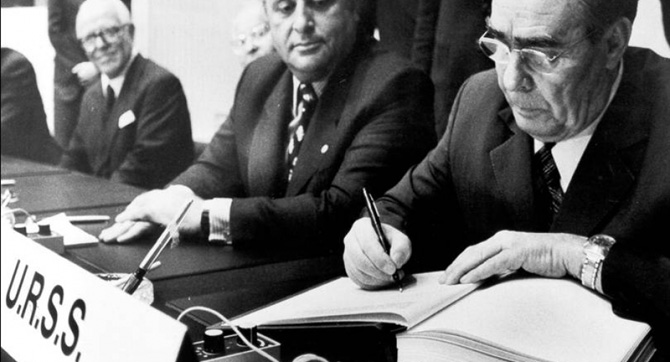
Helsinki Final Act, 1975. Reunification of Families Divided by International Borders
Anahit Shirinyan
Foreign Policy Analys
Background
On 1 August 1975, 35 countries signed the Helsinki Final Act at the Conference on Security and Cooperation in Europe (CSCE), in what was the culmination of détente between the West and the Soviet Union amidst the Cold War.
The Helsinki Accords divided issues of mutual interest among its signatories into four “baskets”. Basket I dealt with issues relating to security in Europe. Basket II focused on economic, scientific and environmental cooperation. Basket III emphasized human, informational, cultural and educational contacts, including freedom of movement and reunification of families divided by international borders. The fourth basket detailed on follow-up mechanisms to review implementation.
The Helsinki Accords were a significant step towards smoothing East-West tensions and establishing principles of interactions among its signatories.
To those on both sides of the Iron Curtain, the Helsinki Accords were deemed as a diplomatic triumph, albeit for different reasons.
For the Soviets, the Final Act clauses on inviolability of frontiers and non-interference in internal affairs signified consolidation of its territorial gains in the Eastern Europe following the Second World War. The Soviet Union subsequently stressed Basket I and II provisions in relations with the rest of the signatories. Whereas for the West, the real significance was the Soviet commitment to human rights provisions of the Helsinki Final Act. It has subsequently stressed the Accords’ human rights and humanitarian provisions over the others. This conflicting prioritization by the Soviet Union and the West reflected their policy interests within the East-West ideological divide.

Historians often refer to the Helsinki Accords as the ‘fatal triumph’ of the Soviet diplomacy. The Final Act empowered human rights activists and dissidents throughout the Eastern Bloc countries. Helsinki Groups were established throughout the Soviet bloc countries and the West to monitor and report on compliance with and implementation of the Accords. Many believe the Accords put a start to the eventual demise of the Eastern Bloc and subsequently also the Soviet Union.
Basket III provision on reunification of families
Inter alia, Basket III included provisions on human contacts, visits for family members and reunification of families. The participating states committed to “deal in a positive and humanitarian spirit with the applications of persons who wish to be reunited with members of their family”, do that “as expeditiously as possible” and “lower where necessary the fees charged in connection with these applications to ensure that they are at a moderate level”.
An important issue in post-war Europe with divided families, this had repercussions for the Soviet Union’s emigration policy -- a thorny issue between the East and the West throughout the Cold War. The Final Act provisions on reunification of families were precisely reflective of the difficulties that a citizen of an Eastern Bloc country would face at attempt to legally emigrate from his/her country. Emigration from the Soviet Union and other Eastern Bloc countries was restricted. This was in line with the Soviet socialist ideology and its antagonism with the capitalist world. The very idea of emigration was against the notions of centralized governance, the collective interest, subordination of the need of an individual to the need of the state, the sense of being besieged by a hostile world. War losses, low birth rates, labour shortage and brain drain were reinforcing this policy. Emigration was seen as opposition to the soviet socialist system and hence considered treason.
While emigration wasn’t explicitly banned, it was arbitrary to the decision of Soviet administrative authorities. Those wishing to leave the country could do so only after receiving an exit visa from state authorities. This involved long, complicated and costly procedures with high risk of being refused. The mere application for emigration would often result in the applicant’s dismissal from job and arrest. Exit visas would be rejected most frequently on “national security” grounds, such as the applicant’s knowledge of “state secrets”. Permits to emigrate were granted mainly for family reunification purposes, and even those assumed long and complicated administrative procedures.
Prior to the Helsinki Accords, other international treaties and agreements -- UN Charter (1946), Universal Declaration of Human Rights (1948), European Convention of Human Rights (1950), International Convention on the Elimination of All Forms of Racial Discrimination (1965), International Covenant on Civil and Political Rights (1966) – guaranteed, to various degrees, the right to leave one's country for temporary travel or permanent residence abroad as well as established general protection of the family. These, however, did not dictate any rules covering family reunification. The Final Act had more specific details on the implementation of this right. It was the non-binding Helsinki Final Act that brought the emigration issues of the Soviet bloc to the forefront of attention. Apart from its technically wider coverage of the issue, it also had a special political significance as a milestone in the détente between the East and the West.
The Soviet emigration volumes were a barometer of East-West relations and a measure as to what degree the Soviets complied with their human rights commitments. While the West prioritized, among other human rights, the implementation of the right for emigration, the USSR would interpret it as an intervention into its internal affairs.
Wary of creating a precedent of free movement, the Eastern Bloc countries limited emigration to family reunification and repatriation purposes. These were justified as special cases. Subsequently, three national groups which fell under this category benefitted from the practice: Jews, Germans, and Armenians. There was strong external pressure on the Soviet Union on behalf of these groups. During 1948-1970, when emigration remained extremely limited, several thousands of mainly elderly Jews were allowed to reunite with their families in Israel under pressure from the Israeli government. Similarly, several thousand ethnic Germans were allowed to emigrate to the Federal Republic of Germany in the 1950s and 60s, under pressure from Bonn.
The trigger for Armenian emigration was different from that of the others. It came from ethnic Armenian immigrants to the Armenian SSR – survivors of the Armenian Genocide and their descendants spread throughout the world -- who had moved to Armenia following the Second World War in response to the call of the Soviet authorities to return and help rebuild their homeland. In 1946-1960, as various sources estimate, around 100.000Armenians from Europe, Middle East, Iran, North Africa and the United States returned. Finding the bitter reality of the Soviet Union, and disillusioned, they therefore sought opportunity to return to their former homes. In the 1950s, it was under pressure from the French government that an unidentified number of French-Armenians were allowed to leave for France on grounds of “repatriation”.
The détente and surge in emigration
The period during détente, however, did see loosening of the Soviets’ emigration policies, and more people were allowed to emigrate between 1971-8o. The effect of the Helsinki Accords was also significant. Its signature triggered an upsurge in emigration applications throughout the Eastern Bloc countries. Soviet eagerness to create a somewhat positive image for itself abroad and relaxations of internal control allowed some more room for demonstrations, petitions and demands from prospective emigrants.
These developments inspired the establishment of Helsinki Committees throughout Soviet Union and Eastern Europe which would monitor and compile reports on the compliance of Eastern Bloc countries with the Final Act. These Committees were soon supported by similar groups in the US and Western Europe. Their reports addressed broad range of human rights issues in general, including difficulties in emigration and reunification of families, offering great breadth of unprecedented coverage of the situation on the ground. These were used as reference at CSCE follow-up meetings on Accords’ implementation. Monitoring by the Helsinki groups, as well as the US and other Western governments created significant pressure points on the Eastern Bloc governments.
Following the signature for the Helsinki Final Act, administrative procedures for receiving exit visas were revised only minimally. Yet, the countries of the Eastern Bloc started to deal in more "positive and humanitarian spirit" with the applications of those who wished to travel and reunite with families.
After 1970, a growing number of Jews applied to emigrate on family reunification grounds. Most went to Israel, others resettled in the United States. In 1973, the US made easing on Soviet emigration controls a condition to removing trade barriers. Apart from the effects of the détente, German emigration in the 1970s was facilitated by West German chancellor Willy Brandt’s Ostpolitik and rapprochement between Bonn and Moscow. The Eastern Bloc countries were also driven by financial interests in allowing exodus of migrants. Israel and West Germany would offer financial inducements, including “ransom” and loans in exchange for the migrants. For example, Israel negotiated such a deal with the Socialist Republic of Romania: overall 235.000 Jews emigrated from Romania to Israel under the deal which included the price of $2,000 to $3,300 per migrant. Armenians too continued to emigrate en-masse during the détente, resettling primarily in the US, as well as Western Europe, Greece, Middle East. However, during the détente, there was no foreign government lobbying on the behalf of Armenians. In its turn, the Armenian Diaspora saw Armenia as its homeland and deplored emigration from there. Historians suggest various explanations as to why Armenians were allowed to leave along with the Jews and Germans. Some consider this to be a reflection of Moscow’s neglect of Soviet Armenia as well as a desire of the Soviet central authorities and Soviet Armenian officials to get rid of “troublesome elements”. Moscow could also aim at dispelling the impression that the Soviets gave in to Western pressure in permitting Jewish and German emigration by allowing another nationality -- also eligible for family reunification -- to leave.
Importantly, emigration for representatives of other nations remained relatively small. Some reports suggest that those seeking to emigrate to the United States or other Western countries, whether for family reunification purposes or not, were compelled by Soviet authorities to leave the Soviet Union under the pretext of being reunited with relatives in Israel.
After the collapse of the détente with the Soviet entry into Afghanistan, emigration saw a sharp restriction within 1980-86. After 1986, Soviet leader Mikhail Gorbachev’s policies of glastnost and perestroika resulted in lessening of controls and a new surge in emigration from the Soviet Union and Eastern Europe.
Bibliography:
Sidney Heitman, The Third Soviet Emigration, 1948-91, Refuge, Vol 13, No. 2 (May 1993)
Stephen H. Meeter, The Relation of the Helsinki Final Act to the Emigration of Soviet Jews, 1 B.C. Int'l & Comp. L. Rev. 111 (1977)
Basket Three: Implementation of the Helsinki Accords, Hearings before the Commission on Security and Cooperation in Europe, Ninety-Fifth Congress, First Session on Implementation of the Helsinki Accords, Volume I, Washington 1977
Implementation of the Final Act of the Conference on Security and Cooperation in Europe: Findings and Recommendations Two Years after Helsinki, Report Transmitted to the Committee on International Relations U.S. House of Representatives by the Commission on Security and Cooperation in Europe, Washington 1977
This article is prepared as part of the “Two Lives: The Cold War and the Emigration of Armenians” project financed by National Endowment for Democracy (NED).
 Videos
Videos Photos
Photos
Write a comment